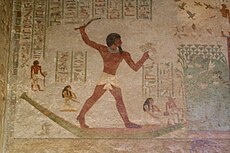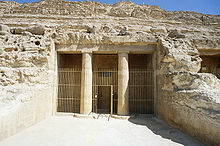What Are The Animals On The Edge Of The Mausoleum
| Khnumhotep Ii Nomarch of the 16th nome of Upper Egypt | |
|---|---|
 Khnumhotep Ii depicted while hunting waterfowl in the marshes | |
| Predecessor | Nakht or Netjernakht |
| Successor | Khnumhotep Iv |
| Dynasty | 12th Dynasty |
| Pharaoh | Amenemhat Two, Senusret II |
| Begetter | Neheri |
| Female parent | Baqet |
| Wife | Khety; Tjat |
| Children | Nakht, Khnumhotep IV, Khnumhotep III, Neheri, and others |
| Burial | Beni Hasan tomb 3 (BH3) |
Khnumhotep Two (ẖnmw-ḥtp, "Khnum is pleased") was an ancient Egyptian Cracking Chief of the Oryx nome (the 16th nome of Upper Egypt) during the reign of pharaohs Amenemhat Two and Senusret 2 of the 12th Dynasty, Centre Kingdom (20th century BCE). He is well known for his tomb at Beni Hasan and its decorations.
Biography and family unit [edit]
| Khnumhotep |
|---|
| Era: Eye Kingdom (2055–1650 BC) |
| Egyptian hieroglyphs |
He was a fellow member of a powerful family of nomarchs and officials which was likely founded by his grandfather Khnumhotep I and housed in Men'at Khufu. Khnumhotep II held many titles such equally hereditary prince and count, foremost of actions, royal sealer, sole friend, member of the elite, overlord of Nekheb, and also overseer of the Eastern Desert, a position which he held from Year 19 of Amenemhat 2 until at to the lowest degree Yr six of Senusret 2 i.e. the date which appears in Khnumhotep's tomb. Like most nomarchs of the fourth dimension he also held some priestly charges.[ane] : 110–1 [2] : i, 26
His predecessor as nomarch was probably his relative Netjernakht, and Khnumhotep honored him by building his tomb. His mother was Baqet while his begetter was an official named Neheri. Khnumhotep had two wives, the main of them was Khety, herself a daughter of the unnamed nomarch of the neighbouring 17th nome with Hardai as capital. Similar her husband, Khety held a remarkable number of titles such as daughter of a governor, king'south acquaintance, foremost of deportment, lady of the house, and was too a priestess of Hathor and Pakhet. Khnumhotep'south secondary married woman was Tjat who held few, modest titles such as sealer, lady of the house and ane who knows her lord; she is the only known female sealer at the court of a local governor. Those peculiarities and the fact that both consorts appears several times in Khnumhotep'due south tomb suggests that the one between him and Khety was probable a politically arranged marriage while Tjat could have been his truthful dear who was appointed sealer by him in guild to have her closer.[ane] : 136–8 [1] : 160–1
From his two consorts, Khnumhotep Ii had several children:[1] : 136–8
- Nakht inherited his maternal grandfather's charge of nomarch at Hardai
- Khnumhotep IV, followed his father as nomarch of the 16th nome, merely does not announced in his begetter's tomb and is just known by his unfinished tomb at Beni Hasan
- Khnumhotep III entered to the royal court where he managed to go high steward and afterwards vizier
- Neheri was cached in a small tomb at Beni Hasan where a stela of him was found
- another son is known for being a "mayor" in a contiguous nome.
For more virtually Khnumhotep's genealogy, see "Nomarchs of the Oryx nome".
The tomb BH3 [edit]

Khnumhotep II is cached in Beni Hasan in the stone-cut Tomb 3 (BH3), one of the most notable of the whole necropolis. In ancient times, the tomb would have been approached via a path that was distinguishable by nighttime brown boulders on either side; the path extended from the open outer court downward the colina to the border of the cultivated land.[iii] : 52
The tomb is fronted by a columned portico and a small courtyard; the courtyard would have been surrounded by mud-brick walls. The small columned portico is on the w side of the courtyard, direct in front end of the tomb entrance.[2] : 30 The ceiling of the portico is curved similar to the shape of a segmented barrel. The rock around the doorway leading inside the tomb to the chapel was smoothed and flattened, on which a fourteen line inscription is giving the listing of the festal days for the services of funeral offerings, chosen percheru, along with the proper noun and titles of Khnumhotep 2.[3] : 53 The floor of the main chamber (also referred to as the chapel) is sunk into the ground below the level of the open outer court and is descended into by three steps.[3] : 53 The chapel is the main bedroom cut directly back into the cliff almost symmetrical with four columns and two large shafts (that lead to burial chambers) are cut into the floor. These iv master columns back up a ceiling that is divided past three segmented barrel shapes.[four] These vaults are painted in a pattern that may be referencing a tent.[2] : 33 The merely light for this chamber would have come from the doorway to the portico and originally a door, betwixt the portico and the chamber, could have been used to close the tomb to the outdoor elements.[iii] : 52 Percy Newberry notes that the merely remain from the inwards swinging door is the pivot-hole. On the doorjambs are prayers to Osiris and Anubis above a seated Khnumhotep Two who is facing inwards.[two] : 32 At the back of this main room (eastward wall) is a small rectangular shine approached by a step about 13 centimetres (5.1 in) high. Newberry mentions that from his survey of the tomb there was a statue here of a seated Khnumhotep II, but the entire statue had been cut away and only a portion of the seat remains.[3] : 53
On the wall are too depicted Khnumhotep's most notable officials and employees at his local court, which somewhat resemble a downscaled version of the royal courtroom with a local treasurer and many stewards and overseers.[one] : 132
In the main chamber there is an autobiography of the deceased; it begins to the left of the entrance to the shrine and runs counterclockwise effectually the walls of the chief chamber, ending to the correct of the doorway leading to the shrine.[2] : 35 The primary types of information included are about the actions Khnumhotep II performed during his lifetime, his family unit and their lives, too as the close relationship of his family to the royal house, Khnumhotep'due south excellent grapheme, and his request to visitors that offerings are made to him.[2] : 36
On the west wall of the chamber are scenes showing mainly the preparations for the funeral and the resurrection of the deceased.[2] : 81 This is exemplified by the boat voyages making a connection between Khnumhotep 2 and the god Osiris. The orientation of the boats within the tomb literally has them travel south to Abydos (right of the entrance) and north to return (left of the entrance).[5] The wall collectively ensures the tomb possessor of rebirth in the afterlife where he volition exist sustained through cult activities.
On the eastern finish of the n wall there is a large-scale standing effigy of Khnumhotep II receiving offerings primarily of several types of animals and birds.
Procession of the Aamu [edit]


A grouping of West Asiatic foreigners labelled as Aamu ( ꜥꜣmw ), with the leader labelled as a "Hyksos" visiting the Egyptian official Khnumhotep II circa 1900 BC. Tomb of 12th-dynasty official Khnumhotep Ii, at Beni Hasan.[6] [7] : 188 [8]
What makes this tomb stand out among the 39 big rock-cut tombs at Beni Hasan is the well known scene of the Aamu group from Shu, Asiatic nomadic traders who are sometimes considered Hyksos or at least their forerunners; the grouping, led by a man called Absha (or Abisha, Abishai), was bringing offerings to the deceased.[7] : 190 Though there are xv people depicted in the scene, the accompanying inscription mentions in that location were 37 persons.[9]
The west end of the wall has another big-scale effigy of Khnumhotep II only hither he is facing right and using a bow to hunt in the desert which is on the edge of the Egyptian world, the boundary between order (maat) and chaos. It has been interpreted that in this scene Khnumhotep Ii is assuming the office of the king dominating over the chaotic power of the desert.[2] : 88

Many of Khnumhotep's relatives. The sitting woman in the top-middle is his wife Khety
The east wall houses the entrance to the shrine, also equally two large depictions of Khnumhotep Two hunting in the marshes, one on the north side and the other on the south side. To the south he is harpooning ii fishes and to the north he is fowling with a throwing stick.[2] : 105 These hunting in the marshes scenes assist protect the deceased in the afterlife equally well as guarantee his rebirth through connotations of sexuality.[two] : 115 Beneath him, due north of the door, there are pictures of several people fishing and below him on the southward side are representations of fighting boatmen. Collectively this wall represents the perpetual renewal of Khnumhotep 2.
The fourth wall of this tomb, south wall, was dedicated to the celebration of the cult meal of Khnumhotep II and his wife Khety.[two] : 122 The east end of the wall features the deceased seated in front of an offer table covered with offerings holding a flail, traditionally seen as a symbol of royalty or divinity, in his right hand.[two] : 123 At the due west end of the wall there is an illustration of Khety sitting in front end of a total offering tabular array. She is facing left and participating in her husband's repast presented by his cult.[2] : 125 The shrine portrays a smaller version of the offering cult and in many ways can be seen as an expansion from the imitation door of the One-time Kingdom, where a statue inside a niche could take been integrated.[2] : 137 The placing of statues in the chapel itself is a new funerary art manner that appeared in the Middle Kingdom tombs.[x]
References [edit]
- ^ a b c d e Wolfram Grajetzki, Courtroom Officials of the Egyptian Center Kingdom, London 2009.
- ^ a b c d e f thou h i j k l m n Janice Kamrin, The Cosmos of Khnumhotep II at Beni Hasan. London, England: Kegan Paul International, 1999.
- ^ a b c d e Percy Newberry, Beni Hasan. Part 1. London, England: Kegan Paul, Trench, Tubner & Co., Ltd., 1893. Available online
- ^ An illustration of this past George Willoughby Fraser is available in Newberry'south book.
- ^ Illustration from Newberry
- ^ Mieroop, Marc Van de (2010). A History of Ancient Egypt. John Wiley & Sons. p. 131. ISBN978-i-4051-6070-4.
- ^ a b Bard, Kathryn A. (2015). An Introduction to the Archaeology of Aboriginal Egypt. John Wiley & Sons. ISBN978-1-118-89611-two.
- ^ Kamrin, Janice (2009). "The Aamu of Shu in the Tomb of Khnumhotep II at Beni Hassan" (PDF). Journal of Ancient Egyptian Interconnections. ane:three.
- ^ "Procession of the Āāmu". Madain Project. Archived from the original on April 2020.
- ^ Robins, Gay (1997). The Art of Aboriginal Egypt. London: British Museum Press. ISBN0714109886. p. 102
Further reading [edit]
- Lepsius, Grand. R. (1849). "Altes Reich. Dyn XII. Benihassan". Denkmäler aus Ägypten und Äthiopien. Tafelwerke Band IV. Berlin: Nicolaische Buchhandlung. pp. 124−133.
Source: https://en.wikipedia.org/wiki/Khnumhotep_II
Posted by: hurstdreir1946.blogspot.com

0 Response to "What Are The Animals On The Edge Of The Mausoleum"
Post a Comment